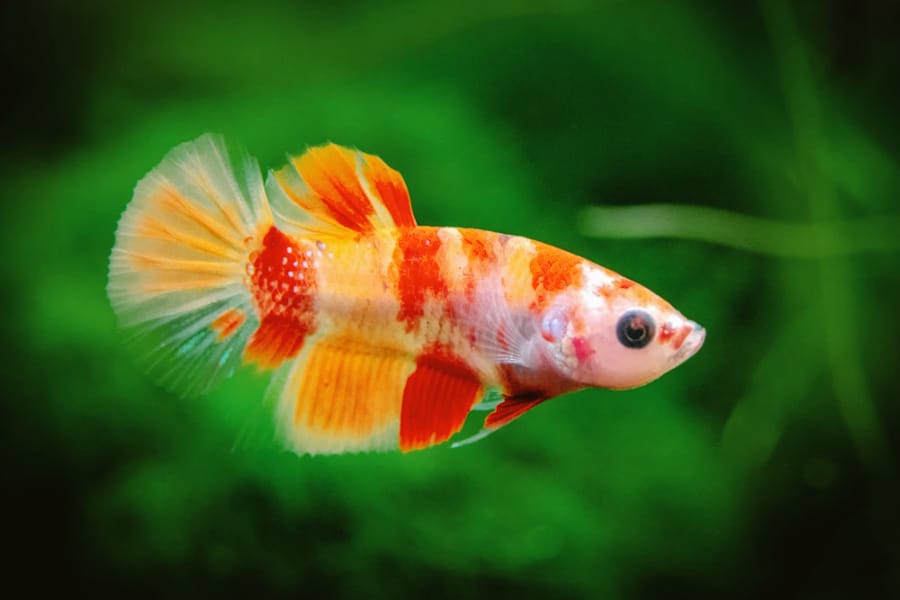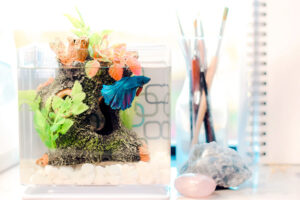For those who are enthusiasts of decorative fish, Koi Betta fish are fancy enough to be a part of your ponds or aquariums. So, what is a Koi Betta fish?
The name was apparently given simply as a marketing label or nickname for a particular hue of a Marble Betta fish—generally a translucent-based body with black and red spots pretty much resembles a Koi fish.
Speaking of a Marble Betta fish, it is actually a name for a transposon or jumping gene—a sequence of DNA that can swap its position inside the genome (the ordering of genes). This is resulting in pigment splotches all over the fish’ fins and body.
Due to the transposon as well, a Marble’s color is not stable, making it often forms new colors or lessens the existing colors themselves. Hence, there is no guarantee that these Marbles can remain in the same color patterns during their lifespan.
As mentioned in the very first paragraph, Koi Bettas are Marble Bettas! Nonetheless, not all Marble Bettas are Koi fish. Since these fish are selected breeds, you won’t see a Koi Betta in the wild areas.
However, Betta Splenden variant is indigenous to swamps and stagnant paddy fields in Southeast Asian regions. There are numerous commercial names for popular breeds of Marble Bettas with mixed colors, some of which are Fancy, Galaxy, Nemo, and certainly, Koi.
Similar to other Betta Splendens, Koi Bettas merely grow to be as long as 3 inches (7.6 cm). For this significant variety, giving additional space for the fish heads is not necessary.
The Origin of Koi Betta Fish

As mentioned previously, Betta fish originates from shallow waterways, floodplains, rice fields, and rivers in many parts of Southeast Asia continent such as Indonesia, Thailand, Vietnam, Malaysia, and southern China.
Due to their habitat, which is a shallow water environment, most enthusiasts consider that these colorful fish are resistant to poor water quality and rapid changes in the environment.
However, the place of origin of the Bettas is in a very stable tropical weather with lots of rainfall to fill the shallow waters so the water quality is maintained, and the water temperature remains steady. Therefore, the fish need an environment with warm water temperatures (24-27 °C) and fairly stable water conditions.
Koi Betta fish can live in low-oxygen water, but it does not mean they need less oxygen than other fish. Bettas have special respiratory organs that allow them to breathe the air directly from the surface of the water, and in fact, they have to.
In an experiment where a Betta’s labyrinthine organs were removed, the fish would suffocate to death even though the water was saturated with oxygen. This is why they must have access to the surface of the water to breathe directly from the atmosphere.
The optimal water for keeping your Koi Bettas healthy should be warm and soft with a neutral to a little acidic pH (6.0 – 8.0).
To resemble the fish’ natural environment, water movement should be low or be placed in a large aquarium. They should be provided with a quiet area in the tank, including a calm area near the water surface.
The fancy fish can be cared for in a community tank as long as water conditions are suitable for them, and there are no aggressive or fin-biting fish there.
Male and Female Koi Betta Fish
To identify physically between a male Koi Betta fish and the female one, you can check out their coloration carefully. The male ones have more intense color patterns with slightly fancier fins than the females do.
In a fish tank, you should keep at minimum five female Koi Betta fish with one male counterpart. When a female Betta tries to approach the bubble nest, the male one will be aggressively mating to the female.
The aggression is also shown up towards some other aquarium mates. The male Koi Bettas are becoming extremely aggressive in protecting their territories towards the other males.
They will fight against each other until they are both dead. The males are notoriously too aggressive that they could even fight their own reflection on the tank wall. Therefore, it is too dangerous to place two or more male Koi Bettas in the same fish tank.
Only one male Koi Betta can be kept in each fish tank. Otherwise, they have to be separated from bulkheads. These wonderful decorative fish will generally prefer an aquarium containing lots of either real or faux plants (the artificial ones are made of silk or plastic) to add a more natural ambiance to their habitat.
The Lifespan of Koi Betta Fish
How long do Koi Betta Fish live? A healthy Koi Betta fish—the one with a good diet and kept in ideal water conditions will live until three years at maximum.
Unfortunately, as the fish have been crossed bred too much to get the perfect new breeds, they become prone to diseases like swim bladders disorder and fin rots.
Even worse, if they have tumors caused by bacterial infections or superficial abrasions, the only way out is to euthanize them in a merciful way.
So, are you interested in keeping some Koi Betta fish in your aquarium or pond now? Go ahead and enjoy the beauty of the fanciful fish!



